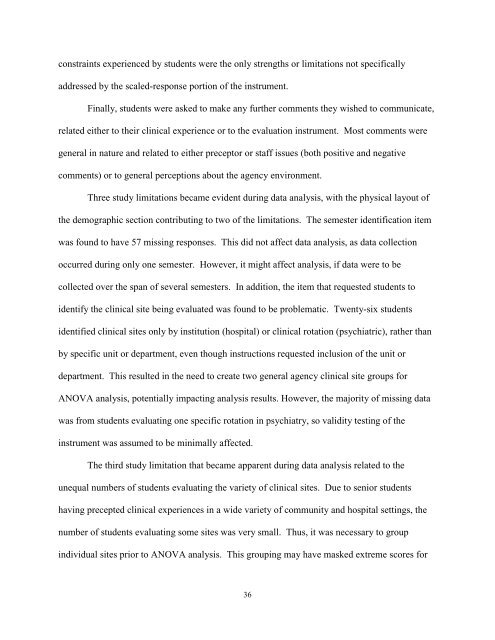STUDENT EVALUATION OF CLINICAL EDUCATION ENVIRONMENT
STUDENT EVALUATION OF CLINICAL EDUCATION ENVIRONMENT
STUDENT EVALUATION OF CLINICAL EDUCATION ENVIRONMENT
Create successful ePaper yourself
Turn your PDF publications into a flip-book with our unique Google optimized e-Paper software.
constraints experienced by students were the only strengths or limitations not specifically<br />
addressed by the scaled-response portion of the instrument.<br />
Finally, students were asked to make any further comments they wished to communicate,<br />
related either to their clinical experience or to the evaluation instrument. Most comments were<br />
general in nature and related to either preceptor or staff issues (both positive and negative<br />
comments) or to general perceptions about the agency environment.<br />
Three study limitations became evident during data analysis, with the physical layout of<br />
the demographic section contributing to two of the limitations. The semester identification item<br />
was found to have 57 missing responses. This did not affect data analysis, as data collection<br />
occurred during only one semester. However, it might affect analysis, if data were to be<br />
collected over the span of several semesters. In addition, the item that requested students to<br />
identify the clinical site being evaluated was found to be problematic. Twenty-six students<br />
identified clinical sites only by institution (hospital) or clinical rotation (psychiatric), rather than<br />
by specific unit or department, even though instructions requested inclusion of the unit or<br />
department. This resulted in the need to create two general agency clinical site groups for<br />
ANOVA analysis, potentially impacting analysis results. However, the majority of missing data<br />
was from students evaluating one specific rotation in psychiatry, so validity testing of the<br />
instrument was assumed to be minimally affected.<br />
The third study limitation that became apparent during data analysis related to the<br />
unequal numbers of students evaluating the variety of clinical sites. Due to senior students<br />
having precepted clinical experiences in a wide variety of community and hospital settings, the<br />
number of students evaluating some sites was very small. Thus, it was necessary to group<br />
individual sites prior to ANOVA analysis. This grouping may have masked extreme scores for<br />
36












